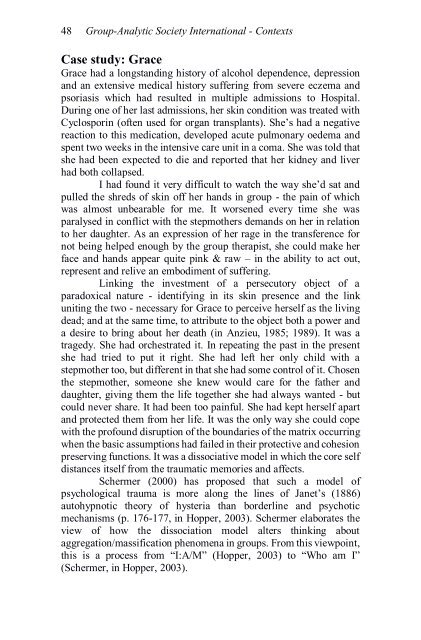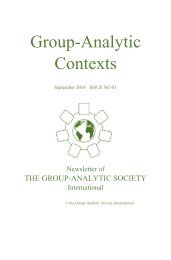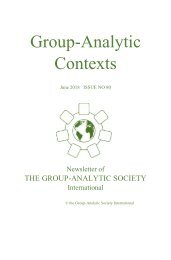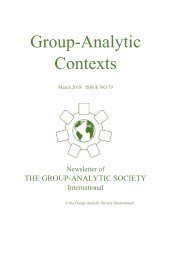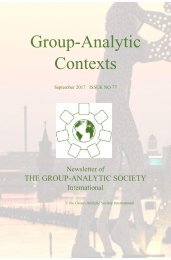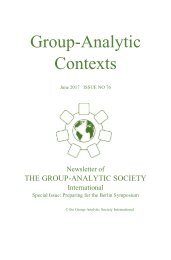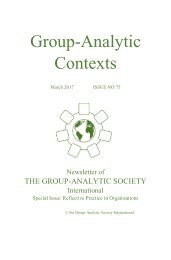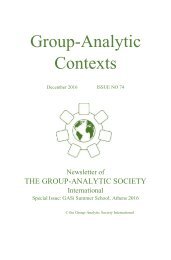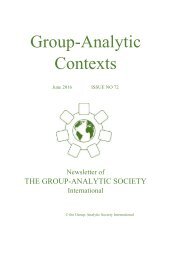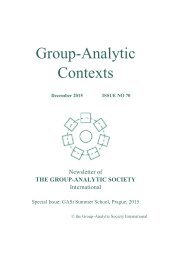Group-Analytic Contexts, Issue 78, December 2017
Create successful ePaper yourself
Turn your PDF publications into a flip-book with our unique Google optimized e-Paper software.
48 <strong>Group</strong>-<strong>Analytic</strong> Society International - <strong>Contexts</strong><br />
Case study: Grace<br />
Grace had a longstanding history of alcohol dependence, depression<br />
and an extensive medical history suffering from severe eczema and<br />
psoriasis which had resulted in multiple admissions to Hospital.<br />
During one of her last admissions, her skin condition was treated with<br />
Cyclosporin (often used for organ transplants). She’s had a negative<br />
reaction to this medication, developed acute pulmonary oedema and<br />
spent two weeks in the intensive care unit in a coma. She was told that<br />
she had been expected to die and reported that her kidney and liver<br />
had both collapsed.<br />
I had found it very difficult to watch the way she’d sat and<br />
pulled the shreds of skin off her hands in group - the pain of which<br />
was almost unbearable for me. It worsened every time she was<br />
paralysed in conflict with the stepmothers demands on her in relation<br />
to her daughter. As an expression of her rage in the transference for<br />
not being helped enough by the group therapist, she could make her<br />
face and hands appear quite pink & raw – in the ability to act out,<br />
represent and relive an embodiment of suffering.<br />
Linking the investment of a persecutory object of a<br />
paradoxical nature - identifying in its skin presence and the link<br />
uniting the two - necessary for Grace to perceive herself as the living<br />
dead; and at the same time, to attribute to the object both a power and<br />
a desire to bring about her death (in Anzieu, 1985; 1989). It was a<br />
tragedy. She had orchestrated it. In repeating the past in the present<br />
she had tried to put it right. She had left her only child with a<br />
stepmother too, but different in that she had some control of it. Chosen<br />
the stepmother, someone she knew would care for the father and<br />
daughter, giving them the life together she had always wanted - but<br />
could never share. It had been too painful. She had kept herself apart<br />
and protected them from her life. It was the only way she could cope<br />
with the profound disruption of the boundaries of the matrix occurring<br />
when the basic assumptions had failed in their protective and cohesion<br />
preserving functions. It was a dissociative model in which the core self<br />
distances itself from the traumatic memories and affects.<br />
Schermer (2000) has proposed that such a model of<br />
psychological trauma is more along the lines of Janet’s (1886)<br />
autohypnotic theory of hysteria than borderline and psychotic<br />
mechanisms (p. 176-177, in Hopper, 2003). Schermer elaborates the<br />
view of how the dissociation model alters thinking about<br />
aggregation/massification phenomena in groups. From this viewpoint,<br />
this is a process from “I:A/M” (Hopper, 2003) to “Who am I”<br />
(Schermer, in Hopper, 2003).


